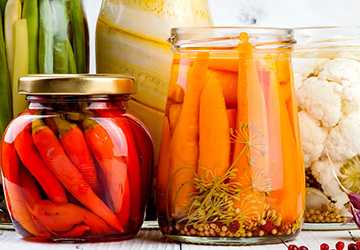How to Ferment Your Vegetables at Home
Fermenting vegetables at home is more than just preserving cucumbers and cabbage. It's an ancient art of cooking, a dance with microorganisms that transforms simple ingredients into delicious, probiotic-rich delicacies. This guide reveals the secrets to successful fermentation and provides five essential tips to help you start your adventure.
Fermenting vegetables at home is more than just preserving cucumbers and cabbage. It's an ancient art of cooking, a dance with microorganisms that transforms simple ingredients into delicious, probiotic-rich delicacies. This guide reveals the secrets to successful fermentation and provides five essential tips to help you start your adventure.
So put on your apron, clear some counter space, and dive into the fascinating world of homemade fermentation.

Start with the Basics: Clean and Simple Ingredients
When fermenting vegetables, simplicity is vital. Start with your choice of fresh, organic vegetables. Carrots, cabbage, cucumbers and peppers are great for beginners. Ensure your vegetables are thoroughly clean and free of pesticides or waxy coatings.
Next, collect good-quality salt. Choose non-iodized sea salt or pickling salt. The iodine in regular table salt can interfere with fermentation, so it's best to stick with pure iodine. Salt acts as a natural preservative and helps create an ideal environment for beneficial bacteria to thrive.
Invest in quality equipment: glass jars and weights
You don't need an extravagant lab to ferment vegetables successfully. Mason jars are your best friend on this trip. Opting for wide-mouth jars makes it easier to pack and remove vegetables. Ensure the jars are clean but not sterile – we want the good bacteria to feel at home!
Invest in fermentation weights or use clean stones to brine the vegetables. This prevents unwanted mould and provides an anaerobic environment that promotes the growth of healthy lactobacilli.
Master the art of patience: Give yourself time to ferment
Fermentation is a slow dance. Once your vegetables are in the salt bath, don't look at them every few hours. Patience is essential for successful fermentation. Fermentation can take a few days to a few weeks, depending on the vegetables and temperature.
It's essential to burp every few days to release excess gas. Carefully open the lid and allow the gas to escape. This prevents explosions and ensures your fermentation remains safe and healthy.
Experiment with flavours: Try spices and herbs
One of the joys of fermenting vegetables at home is the ability to infuse them with exciting flavours. Experiment with different spices and herbs to up your fermentation game. Garlic, ginger, dill and coriander seeds are popular choices.
Feel free to get creative – add a touch of heat with chilli flakes or sweetness with a cinnamon stick. Remember to keep it simple, especially initially, to see how the flavours develop during fermentation.
Trust your senses: taste and smell as you go
Your senses are your best guide to fermentation. When you transform vegetables, pay attention to changes in aroma, texture, and flavour—a slight spiciness and tangy flavour sign that your veggies are on track.
Once fermentation has reached the desired flavour profile, place the jars in the refrigerator to slow fermentation. But that doesn't mean the flavour of the final fermented vegetables will develop over time.
It depends on the temperature: find the optimal fermentation point
Temperature plays a vital role in the fermentation process. You should store your vegetables in a cool, dark place out of direct sunlight. Fermentation is like a Goldilocks situation—too hot, and it accelerates too much; too cold, and it slows to a crawl.
The optimal range is around 15-24°C. If your kitchen is too hot, consider a more relaxing spot or use a refrigerator for slower, controlled fermentation. Experiment with different temperatures to find the best for your unique kitchen environment.

Hygiene is your ally: keep it clean, not clinical
While cleaning is essential, disinfecting should be balanced. A little natural bacteria is a friend in the fermentation game. Wash your hands, dishes and glasses thoroughly, but avoid using antibacterial soaps. The beneficial bacteria responsible for fermentation thrive in lightly polluted environments.
Maintain basic hygiene without a trip to the clinic, and your fermentation will thank you. A sterile environment prevents the development of rich, complex flavours unique to home fermentation.
Accept imperfections: not every batch is perfect
Fermenting vegetables is an art, not an exact science. Rest assured that your first batch goes precisely as planned. Factors such as humidity, freshness of the vegetables, and even water use can affect the results.
Accept imperfection as part of the learning process. You'll learn something new about the art of fermentation with every batch. Take notes, adjust your approach, and enjoy the uniqueness of each homemade creation. After all, the quirks make your fermentation truly your own.
Watch out for water: chlorine and fermentation don't mix
Water may seem harmless, but not all water is equal when fermenting vegetables. Tap water often contains chlorine, which can inhibit the growth of beneficial bacteria that are important for fermentation. Before making the brine, let the tap water sit for at least 24 hours to allow the chlorine to evaporate.
Alternatively, you can use filtered or bottled water to ensure a chlorine-free environment for fermentation. This minor tweak can significantly impact your home fermentation's success and flavour complexity. So take care of your water and let the fermentation magic happen in chlorine-free heaven.
Diploma
Enjoy your first crunchy bite of homemade fermented vegetables and revel in the power of transforming raw produce into a symphony of flavour. The journey may begin with hesitation but end with the satisfaction of mastering the art of fermentation. Whether it's the spice of sauerkraut or the taste of kimchi, every cup is a testament to your newfound skills.
So enjoy the glory of fermentation, share your creations with friends, and most importantly, get those jars ready because the world of homemade fermentation is limitless and endlessly rewarding. Cheers to your extraordinary life ahead!